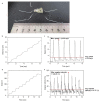Design of a Biologically Inspired Water-Walking Robot Powered by Artificial Muscle
- PMID: 35457930
- PMCID: PMC9027874
- DOI: 10.3390/mi13040627
Design of a Biologically Inspired Water-Walking Robot Powered by Artificial Muscle
Abstract
The agile and power-efficient locomotion of a water strider has inspired many water-walking devices. These bioinspired water strider robots generally adopt a DC motor to create a sculling trajectory of the driving leg. These robots are, thus, inevitably heavy with many supporting legs decreasing the velocity of the robots. There have only been a few attempts to employ smart materials despite their advantages of being lightweight and having high power densities. This paper proposes an artificial muscle-based water-walking robot capable of moving forward and turning with four degrees of freedom. A compliant amplified shape memory alloy actuator (CASA) used to amplify the strain of a shape memory alloy wire enables a wide sculling motion of the actuation leg with only four supporting legs to support the entire weight of the robot. Design parameters to increase the actuation strain of the actuator and to achieve a desired swing angle (80°) are analyzed. Finally, experiments to measure the forward speed and angular velocities of the robot are carried out to compare with other robots. The robot weighs only 0.236 g and has a maximum and average speed of 1.56, 0.31 body length per second and a maximum and average angular velocity of 145.05°/s and 14.72°/s.
Keywords: SMA actuator; biologically inspired robots.
Conflict of interest statement
The authors declare no conflict of interest.
Figures









References
-
- Wood R.J. The first takeoff of a biologically inspired at-scale robotic insect. IEEE Trans. Robot. 2008;24:341–347. doi: 10.1109/TRO.2008.916997. - DOI
-
- Hoover A.M., Steltz E., Fearing R.S. RoACH: An autonomous 2.4 g crawling hexapod robot; Proceedings of the RoACH: An Autonomous 2.4 g Crawling Hexapod Robot; Nice, France. 22–26 September 2008; pp. 26–33.
-
- Hu D.L., Bush J.W.M. The hydrodynamics of water-walking arthropods. J. Fluid Mech. 2010;644:5–33. doi: 10.1017/S0022112009992205. - DOI
Grants and funding
LinkOut - more resources
Full Text Sources

